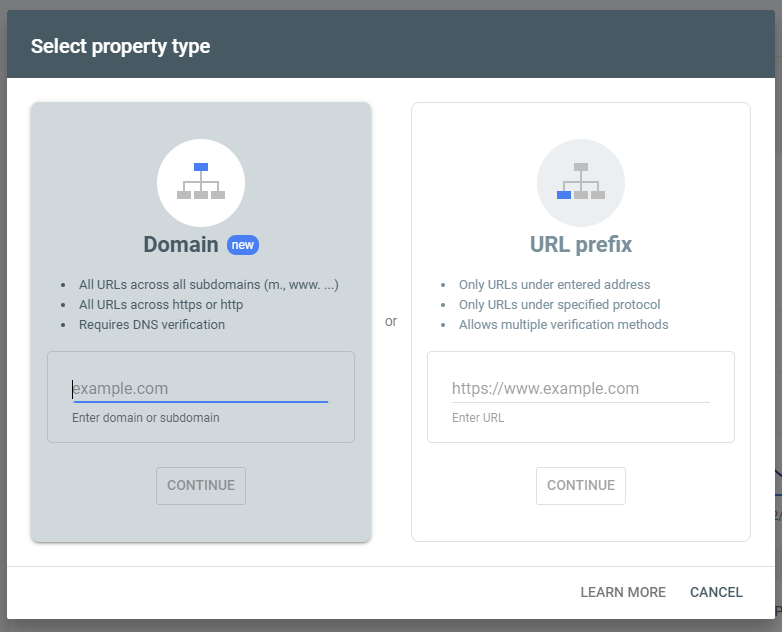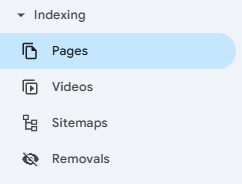How to Use Google Search Console to Improve Indexing & Visibility
One of the very first things you’ll want to do when wanting to improve your site’s indexing and visibility is to connect it to Google Search Console.
The free tool provided by Google allows you to do things like submit a sitemap, check for errors, and optimise your site for better visibility.
However at a glace.. many find the inside of the Google Search Console can be a little overwhelming. By the end of this article, you will better understand the initial areas you need to focus on to gain better traction in the search results.
However before we begin, its important you understand the difference between indexing and ranking first. Already savvy, then keep reading.
Google Search Console Overview
Google Search Console provides insights into how Google views your site, helping you understand its performance in search queries. By using this tool, you can monitor the indexing status of your pages, identify issues, and optimize your content for better performance.
One of the key features of Google Search Console is its ability to track your website’s search traffic. You can see which keywords drive visitors to your site and how your pages rank for those terms.
This information allows you to make informed decisions about your SEO strategy. But that’s just the tip of the ice-berg. When we dig further, we can start to understand why the Google Search Console in an invaluable tool to anyone looking to increase their online visibility.
You may also like common indexing issues
Setting Up Your Account
To get started with Google Search Console, you’ll need to create an account. Its straightforward and only requires a Google account. If you don’t have one, it’s easy enough to set up.
Once you have your Google account ready, you can head over to Google Search Console and sign in.
A few things to think about:
- Determine your website’s primary domain: Decide if you want to track the “www” version or the non-www version.
- Gather necessary information: You’ll need to provide details about your website, including the URL.
- Understand the features: Familiarize yourself with the dashboard layout and the various tools available, such as Performance and Coverage reports.
By taking the time to create your account properly, you’ll guarantee you’re ready to effectively monitor your site’s indexing status and visibility in search results.
Of course, all of this effort can be wasted time if you do not have proper website structure and a strong foundation throughout your site.
Without a clear and organized structure, search engines may struggle to crawl and rank your pages efficiently. So make sure you have the fundamentals in place before working on your visibility. You can conduct a website audit in under an hour audit to give you an idea on where you need to direct your attention
Verifying Your Website
You’ll need to choose a verification method. Google offers several options, including HTML file upload, HTML tag, Google Analytics, and Google Tag Manager. Each method has its own set of instructions, so pick the one that suits you best.

If you opt for the HTML file upload, download the provided file from Google, then upload it to your website’s root directory. Once you’ve done that, return to Google Search Console and click the “Verify” button.
With the HTML tag method, you’ll need to copy a meta tag provided by Google and paste it into the header section of your website. You can do this by installing a header and footer plugin.
If you use Google Analytics and have the tag already on your site, Google will automatically verify it.
Understanding Index Coverage Reports
Once you’ve verified your website in Google Search Console, you can start exploring the Index Coverage Reports.
 These reports provide you with key insights into how Google crawls and indexes your site. To access this information, select the “Pages” option from the left hand menu in the Search Console.
These reports provide you with key insights into how Google crawls and indexes your site. To access this information, select the “Pages” option from the left hand menu in the Search Console.
It’s important to note that this information isn’t necessarily a bad thing. In many cases, pages in these reports are intentionally left unindexed
By examining this data, you can identify any issues that might affect your website’s visibility in search results.
These reports categorize your pages into different statuses, helping you understand which pages are indexed, which have errors, and which are excluded.

Here’s what each issue means and what you can do about it.
From the top.
Excluded by ‘noindex’ Tag
This happens when your page has a piece of code telling Google not to index it. If that’s what you intended, no problem. But if you want the page to show up in search, you’ll need to remove the noindex tag.
Page with Redirect
If a page is set to send visitors somewhere else, Google won’t index it. That’s normal for things like old pages you’ve redirected to a new version. But if it’s happening by mistake, check your site’s redirects and fix any that aren’t needed.
Redirect Error
Something went wrong with a redirect, and Google couldn’t follow it. This could be a broken link, a redirect loop, or a wrong setup. Use Google’s URL Inspection Tool to see what’s happening and fix the issue.
Not Found (404)
Google tried to visit the page, but it’s gone. If you deleted it on purpose, that’s fine. If not, you might need to restore it or redirect it to a relevant page so visitors don’t land on a dead end.
Alternate Page with Proper Canonical Tag
Your page has the same content as another one, and Google is following the canonical tag you set. This tells search engines which version to index. If the tag is right, you don’t need to do anything. If Google is ignoring the version you want, check your settings.
Duplicate Without User-Selected Canonical
Google found two or more pages with the same content but doesn’t know which one to index. To fix this, set a canonical tag on the page you want Google to prioritize or combine the duplicate content into one page.
Crawled – Currently Not Indexed
Google has looked at your page but decided not to add it to search results. This can happen if the content isn’t strong enough or if Google just hasn’t gotten around to it yet. Try improving the page with better content and internal links, then request indexing.
Discovered – Currently Not Indexed
Google knows your page exists but hasn’t crawled it yet. This can happen if your site has too many new pages at once or if Google thinks the page isn’t important enough. Make sure it’s linked from other pages and included in your sitemap to help speed things up.
Blocked Due to Other 4xx Issue
Your page is blocked because of an error, like a “403 Forbidden” message. This usually means there’s a permission issue or some kind of restriction stopping Google from accessing it. You’ll need to check your settings and remove any blocks if the page should be indexed.
Soft 404
This means Google thinks your page looks like a “not found” page, even though it technically loads. This often happens when a page has very little useful content. If the page is important, add more information to it. If it’s meant to be removed, make sure it returns a proper 404 error.
Submitting Sitemaps
A sitemap acts as a roadmap for search engines, guiding them to your site’s important pages.
By submitting your sitemap through Google Search Console, you help improve your site’s visibility and indexing efficiency.
Sitemap Submission Process
📌 Step 1: Create Sitemap
🛠 Use tools like XML-sitemaps or SEO plugins to generate a structured list of your website’s pages.
⬇
🔑 Step 2: Access Google Search Console (GSC)
📂 Log into Google Search Console and navigate to the correct property for your website.
⬇
📤 Step 3: Submit Sitemap
🔗 Go to the “Sitemaps” section, enter your sitemap URL (e.g., yourwebsite.com/sitemap.xml), and submit it.
⬇
📊 Step 4: Monitor Status
✅ Regularly check for errors or warnings to ensure all URLs are indexed properly.
You may also like optimising your sitemap
Monitoring Mobile Usability
With the increasing number of users accessing sites via mobile devices, you should regularly check how your pages perform on smartphones and tablets.
Mobile Friendly Test – Check Your Site Now

You also might want to check out these mobile friendly design tips.
Steps to Analyzing Search Performance
Understanding how your site performs in search results is key to improving your overall strategy. Google Search Console provides valuable insights into your site’s search performance, helping you identify trends and areas for improvement.
Step 1: Access the Performance report, which shows metrics like clicks, impressions, average position, and click-through rate (CTR). Analyzing these figures allows you to understand what keywords drive traffic to your site and how well your pages rank for those terms.
Step 2: Examine the queries that generate the most impressions and clicks. This information reveals which search terms are relevant to your audience. If certain keywords yield high impressions but low clicks, you should work on your meta titles and descriptions to improve CTR.
Step 3: Look at the performance of individual pages. Identify which pages rank well and which ones may require further enhancement. Pay attention to the average position of your top-performing pages and assess whether they can be improved further.
Step 4: Track your performance over time. By monitoring shifts in traffic and rankings, you can adjust your strategy accordingly, helping make sure that your site maintains maximum visibility in search results.
Identifying and Fixing Errors
Errors on your website can harm your indexing and overall search performance, so it’s vital to identify and fix them promptly. Google Search Console provides valuable insights into various issues that could hinder your site’s visibility.
By regularly checking for errors, you can address them before they affect your audience and search rankings.
Focus on the following areas:
Crawl Errors
These occur when Googlebot can’t access your pages. Look for 404 errors or server issues. Remember that your site’s crawl budget can also influence how often Google revisits your pages for indexing.
Mobile Usability
Verify your site is mobile-friendly. Google prioritizes sites that provide a good experience on mobile devices.
Security Issues
Check for any security problems, such as malware or phishing. Addressing these promptly helps protect your users and your reputation.
Once you’ve identified the errors, take action to resolve them. Whether updating links, improving mobile responsiveness, or improving security, fixing these issues will contribute to better indexing and higher visibility.
Regular monitoring and maintenance are critical, as this proactive approach guarantees your site operates smoothly in the search results.
Utilizing URL Inspection Tool
The URL Inspection Tool in Google Search Console is an important resource for webmasters seeking to improve their site’s indexing.
It allows you to check how Google views your specific URLs. By entering a URL, you can see its current indexing status, any detected issues, and whether it’s eligible for indexing.
To inspect a URL of a recently published or changed/updated page, simply enter the URL into the inspection area and Google will return wether or not the page is elegible for indexing. If it is, you can proceed and “Submit to Google”

You can also view the last crawl date, which helps you understand how frequently Google accesses your site. If you’ve made changes to a page, you can request a re-crawl to make sure these updates are reflected in search results.
This proactive approach can greatly contribute to your site’s overall performance in search results.
For faster indexing, you may want to read this article about rapid URL indexing
Using Insights to Improve Content
You can use the insights gathered from the URL Inspection Tool to improve your content strategy. By examining how your pages are indexed and displayed in search results, you can identify opportunities to improve your content.
This not only helps in refining your existing material but also assists in creating new content that aligns with user intent.
Here are 4 ways to leverage these insights:
- Identify Growth Areas: Discover which keywords are bringing traffic and which pages need optimization based on their current performance.
- Understand User Engagement: Analyze metrics like click-through rates and average position to gauge how well your content resonates with your audience.
- Discover linking opportunities: You can use the search console to find top performiing pages and distribute the seo juice by implimenting internal linking strategies
- Update Outdated Information: Regularly refresh your content to make sure it remains relevant and accurate, boosting both user experience and SEO performance.
Conclusion
By effectively utilizing Google Search Console, you can greatly improve your website’s indexing and visibility.
With these strategies, you’ll not only boost your search rankings but also create a more user-friendly experience for your visitors.

